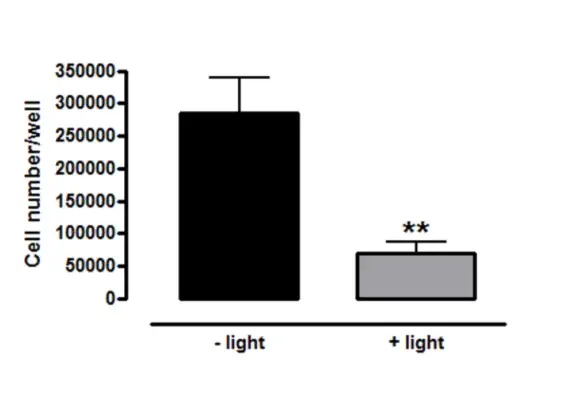Bart’s Hospital in London
Wellcell Cancer Report
The aim of this experiment is to investigate the effects of Wellcell (spontaneous illuminator) on Human endothelial cell growth for the treatment of Cancer.
Scientist: Prof Amrita Ahluwalia, Clinical Pharmacology, William Harvey Research Institute, Barts & The London Medical School.
Aim: To investigate the effects of the wellcell on human endothelial cells. Endothelial cells are the cells that form a single cell layer lining the luminal side of
all blood vessels. These cells play an essential role in maintaining the healthy state of the blood vessel by ensuring adequate provision to vital organs of
nutrients and oxygen and by releasing substances that maintain the patency of blood vessels and prevent blockages (as those that precipitate heart attacks).
In addition, these are the cells involved in the formation of new blood vessels (angiogenesis).
Method: We plated human endothelial cells into 6-well culture plates and counted the cells to monitor proliferation. Endothelial cells will proliferate over
time such that seeding of a small number of cells onto a culture plate over approximately 4 days will proliferate to cover the culture plate area. The rate of
growth can be monitored by counting the number of cells at set times after ‘seeding’ which is how we estimated growth rates in this study.
We conducted two types of experiment. In the first series of experiments the cells received continuous wellcell exposure for the first 48 hours of growth. This
experiment was halted due to the fact that all cell growth was prevented by the wellcell device. In the second series of experiments the cells were allowed to
reach an active growth phase (72 hours, see figure 1 for normal growth pattern) and were then subjected to 12 hours of exposure to the wellcell. Plates were
left to grow in a temperature (37oC), humidity and 5% CO2 in atmospheric O2 environment in an incubator as control. In a separate incubator cells were
subjected to the wellcell which was placed on top of the plate. At the end of this time period cells were collected and counted. Cell viability was assessed by
trypan blue staining.
A further experiment was designed to allow time for the cells to reach an active growth period. At 72 hours growth the cells received 12 hours of exposure to
the wellcell. The growth of the cells was markedly reduced when compared with control (70000 ± 17320 N=4 vs. 285000 ± 53770 N=4 respectively,
p=0.0089), Figure 2. Further investigation also showed the Wellcell to decrease cell viability, i.e. to increase cell death when compared with control (73.00%
± 2.00% N=4 vs. 93.50% ± 3.12% N=4 respectively, p = 0.0015), Figure 3
Figure 2: Number of cells with and without Wellcell light exposure.
Figure 3: Cell viability of cells with and without Wellcell light exposure.
Conclusions:
These experiments demonstrate a profound inhibitory effect of the wellcell on endothelial cell growth. These findings would suggest that the wellcell would
be effective in inhibiting new vessel growth. The potential therapeutic utility of such an effect would likely fall in the area of cancer, where new vessel
growth perpetuates tumour growth and survival. Inhibition of new vessel growth would theoretically deprive the tumour of blood flow and thereby inhibit
further growth.
Recommendations:
The wellcell should be tested both on tumour growth models but also upon models assessing new vessel growth associated with tumour growth. However the
profound effect on endothelial cell growth needs to be viewed with caution. The profound inhibition of cell growth suggests a highly potent effect that
potentially could lead to detrimental effects.
Wellcell Response:
The Wellcell emits harmless light frequencies and the results of this experiment are very encouraging. The professor was a complete skeptic because this
experiment was halted due to the fact that all cell growth was prevented by the wellcell device. She needed to do a second experiment just to confirm that the
first didn’t have some sort of mishap. There is no way that light has any detrimental effects while communicating with cells. Google (Bio-Photons) and read
how our cells communicate with light.



Email: ron@wellcell.com
Web: www.wellcell.com
Address: 20311/61 St Leger way,
Ascot, Queensland 4007
Australia











